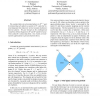406 search results - page 47 / 82 » Pseudorandomness and Combinatorial Constructions |
90
Voted
JAL
1998
15 years 14 days ago
1998
We describe a very general technique for generating families of combinatorial objects without isomorphs. It applies to almost any class of objects for which an inductive construct...
92
Voted
ISVD
2007
IEEE
15 years 7 months ago
2007
IEEE
We consider finite sets of oriented spheres in Rk−1 and, by interpreting such spheres as points in Rk , study the Voronoi diagrams they induce for several variants of distance ...
118
Voted
ACSC
2005
IEEE
15 years 6 months ago
2005
IEEE
A k-separated matching in a graph is a set of edges at distance at least k from one another (hence, for instance, a 1-separated matching is just a matching in the classical sense)...
111
click to vote
CP
2004
Springer
15 years 4 months ago
2004
Springer
Many combinatorial (optimisation) problems have natural models based on, or including, set variables and set constraints. This was already known to the constraint programming commu...
95
Voted
TYPES
2000
Springer
15 years 4 months ago
2000
Springer
Higman's lemma has a very elegant, non-constructive proof due to Nash-Williams [NW63] using the so-called minimal-bad-sequence argument. The objective of the present paper is ...

